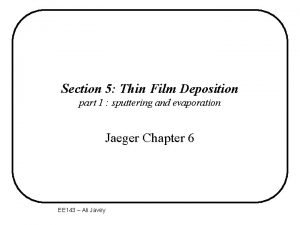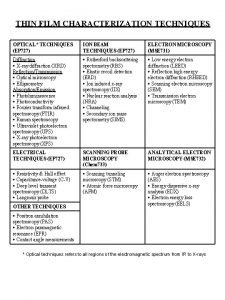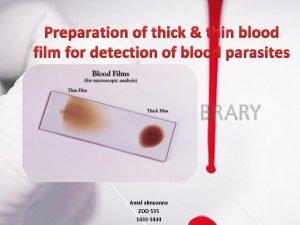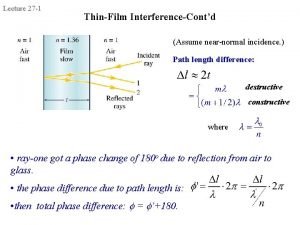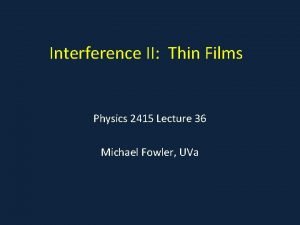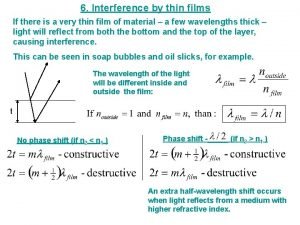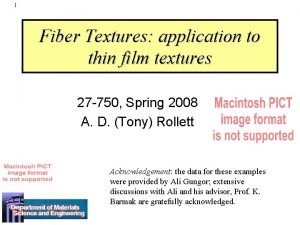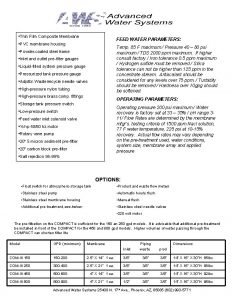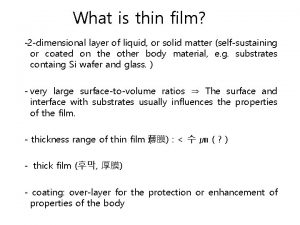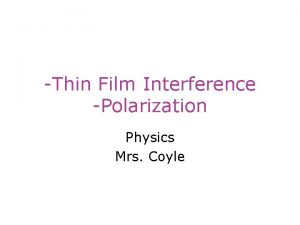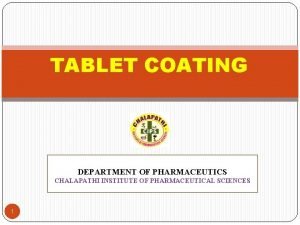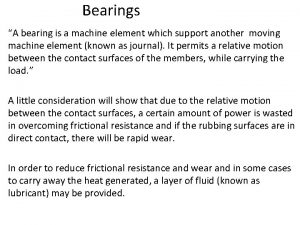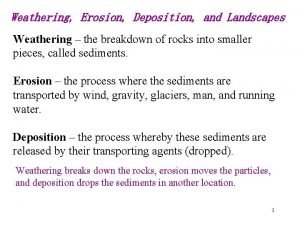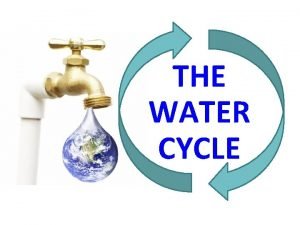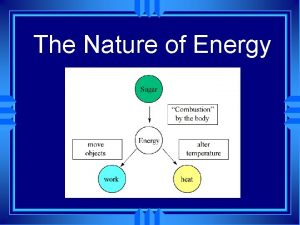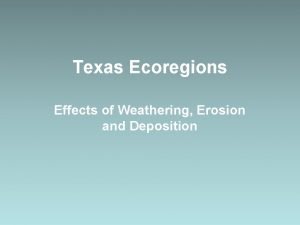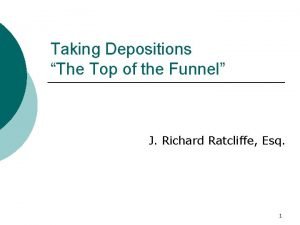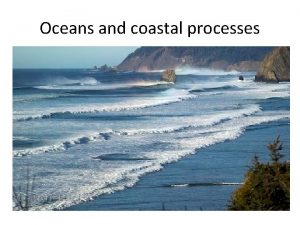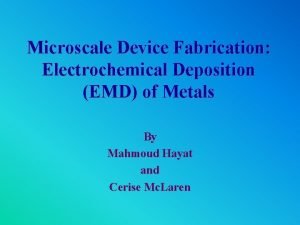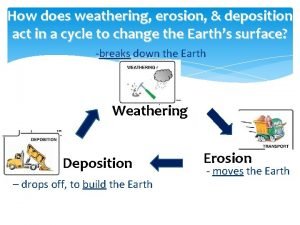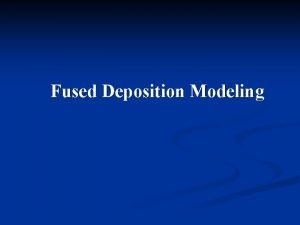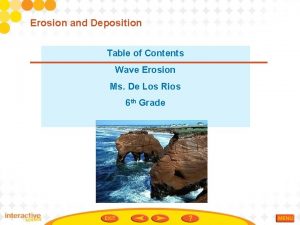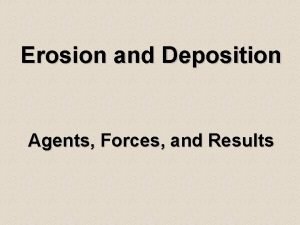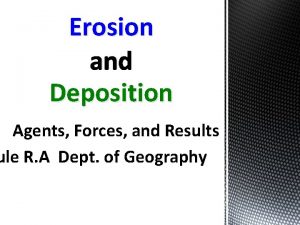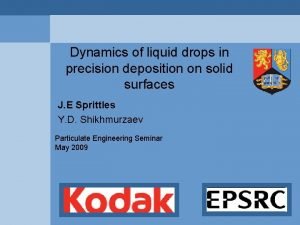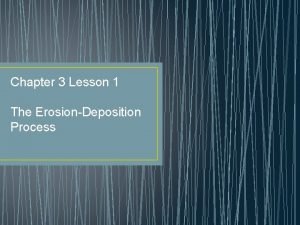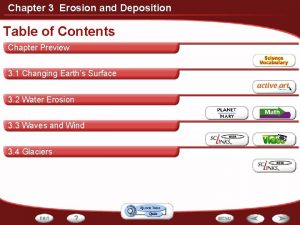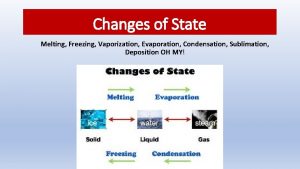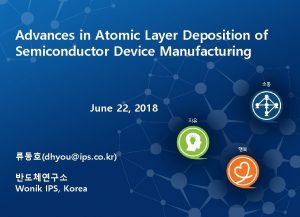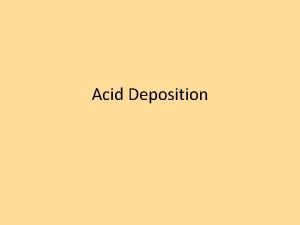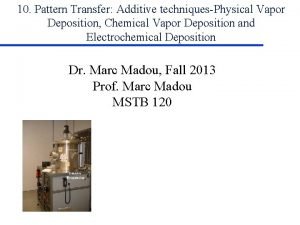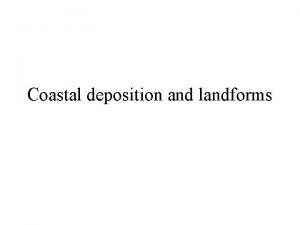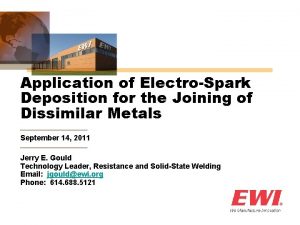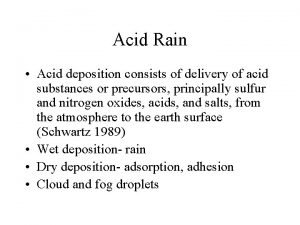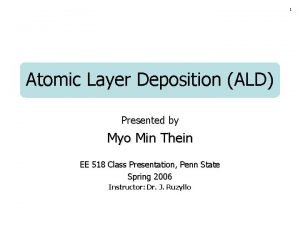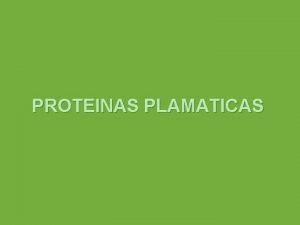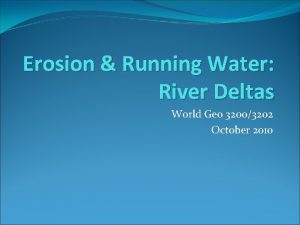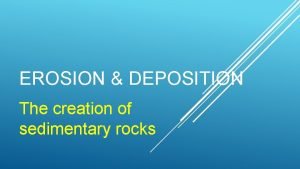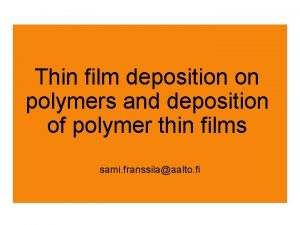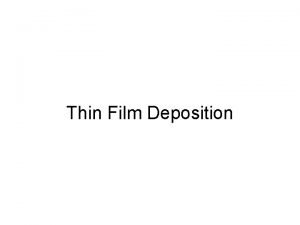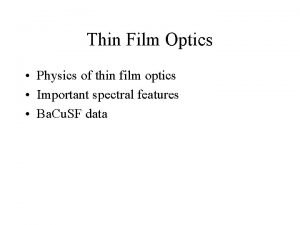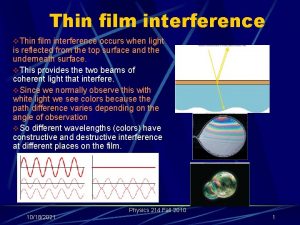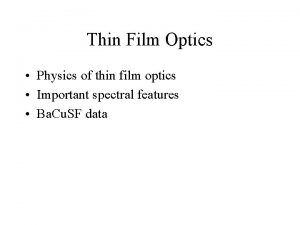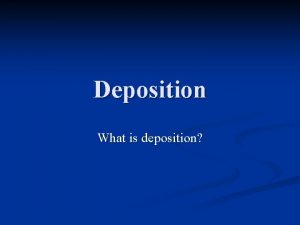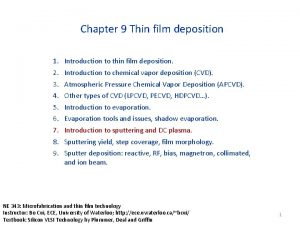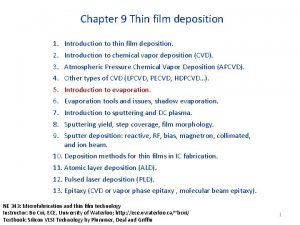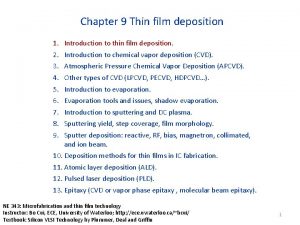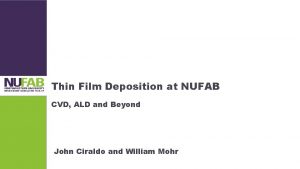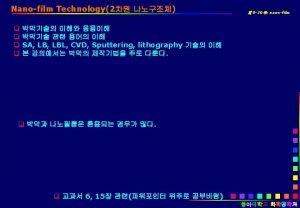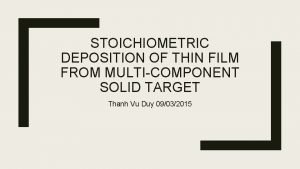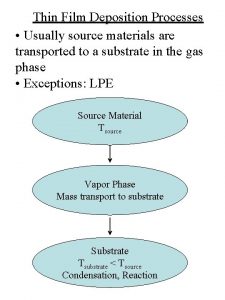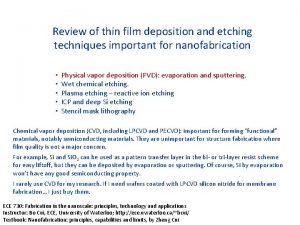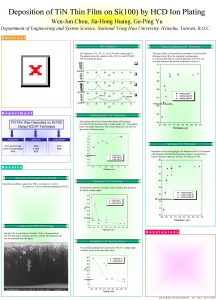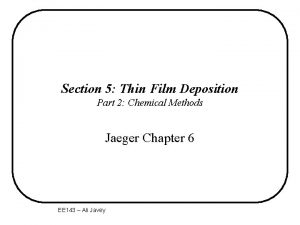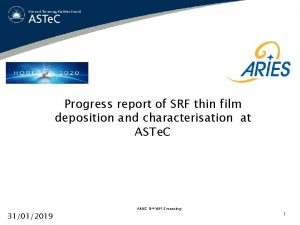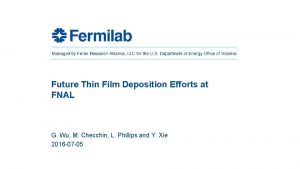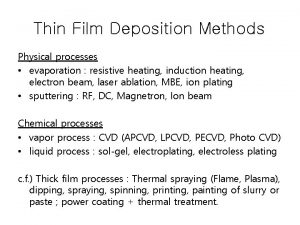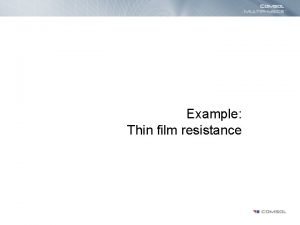Chapter 9 Thin film deposition 1 2 3

















































- Slides: 49

Chapter 9 Thin film deposition 1. 2. 3. 4. 5. 6. 7. 8. 9. Introduction to thin film deposition. Introduction to chemical vapor deposition (CVD). Atmospheric Pressure Chemical Vapor Deposition (APCVD). Other types of CVD (LPCVD, PECVD, HDPCVD…). Introduction to evaporation. Evaporation tools and issues, shadow evaporation. Introduction to sputtering and DC plasma. Sputtering yield, step coverage, film morphology. Sputter deposition: reactive, RF, bias, magnetron, collimated, and ion beam. 10. Deposition methods for thin films in IC fabrication. 11. Atomic layer deposition (ALD). 12. Pulsed laser deposition (PLD). 13. Epitaxy (CVD or vapor phase epitaxy , molecular beam epitaxy). NE 343: Microfabrication and thin film technology Instructor: Bo Cui, ECE, University of Waterloo; http: //ece. uwaterloo. ca/~bcui/ Textbook: Silicon VLSI Technology by Plummer, Deal and Griffin 1

Common deposition methods for thin films in IC fabrication

Epitaxial silicon deposition Advantages of epitaxial wafers over bulk wafers • Offers means of controlling the doping profile (e. g. lightly doped on heavily doped possible) • Epitaxial layers are generally oxygen and carbon free Gases used iin siilliicon epiittaxy

Chemical reactions Concentration o of species at different positions along a horizontal reactor (carrier gas should be H 2) Si. Cl 4 + 2 H 2 Si + 4 HCl Si. Cl 4 concentration decreases while the other three constituents (Si. HCl 3, Si. H 2 Cl 2, HCl) increase.

Equipment Three basic reactor configurations Weight 2000 Kg Occupy 2 m 2 or more of floor space. Quartz reaction chamber with susceptors Graphite susceptors for physical support. A coating of silicon carbide (50 to 500 μm) applied by CVD process on susceptors. • RF heating coil or tungsten halogen lamps (cold wall), water cooling. • • •


Si APCVD epitaxy growth process • Hydrogen gas purges of air from the reactor. • Reactor is heated to a temperature. • After thermal equilibrium, an HCl etch takes place at 1150 o. C and 1200 o. C for 3 minutes. • Temperature is reduced to growth temperature. • Silicon source and dopant flows are turned on. • After growth, temperature is reduced by shutting off power. • Hydrogen flow replaced by nitrogen flow. • Depending on wafer diameter and reactor type, 10 to 50 wafers per batch can be formed. • Process cycle times are about one hour. • Epitaxy film need high temperature (>1000 o. C) because at high temperature the (amorphous) native oxide will become unstable and desorb from the surface, exposing the single crystalline silicon lattice for epitaxy.

Arsine doping and growth processes 2 As. H 3 (gas) 2 As (solid) + 3 H 2 (gas) • Interaction between doping process & growth process • Growth rate influences the amount of dopant incorporated in Si • Equilibrium established at low growth rates. • • • There is also auto-doping, which can be minimized by: Fast growth to minimize out-diffusion. Low temperature deposition reduces boron auto-doping (not As however). Seal backside of substrate with highly doped poly-oxide. Avoid the use of HCl etching. Reduced pressure epitaxy.

Polycrystalline silicon deposition H 2 carrier gas for solid curves • Application: gate of MOSFET. • Usually deposited in a LPCVD chamber at 25150 Pa, 600 -650 o. C, 10 -20 nm/min. • Si. H 4 is preferred because of its lower deposition temperature. Figure 9 -8 • Usually amorphous when deposition at <575 o. C; but may be polycrystalline if deposition rate is low enough. • Columnar grain structure/texture, and the grain will grow when annealed. • When annealed, amorphous Si will become polycrystalline Si with even large grain size than poly-Si under same annealing. 1 Torr = 132 Pa

Grain structure and resistivity Traps states (dopant inactive when trapped there) and scattering at grain boundary limits the resistivity. At higher doping, trap states are all filled and cannot further reduce active dopant concentration.

Deposition rate and oxidation of poly-Si Deposition rate should be pressure since rate ks. CG/N for h. G>>ks, but actually sub-linear. This is because at higher rate, it is determined by desorption of reaction product H 2 (rather than gas transport onto the surface). Oxidation of poly-silicon: • Usually 900 -1000 o. C dry oxidation. • Un-doped or lightly doped poly-Si oxidizes at rate between that of (111) and (100) single crystal Si. • P-doped poly-Si oxidizes faster than un-doped or lightly doped one.

Silicon nitride deposition • Application: o Masks to prevent oxidation for LOCOS process o Final passivation barrier for moisture and sodium contamination o Etch stop for Cu damascene process o Popular membrane material by Si backside through-wafer wet etch. • PECVD • LPCVD • Can also deposit nitride using silane at 700 -900 o. C by APCVD; or use N 2 gas instead of NH 3. LPCVD conformal Si 3 N 4 films Low-stress nitride deposition using DCS (dichloro-silane Si. Cl 2 H 2) 12

Silicon nitride properties tensile or compressive LPCVD film quality is much better than PECVD in almost every aspect. 13

Silicon dioxide deposition Sputtered oxide has poorer step coverage than CVD. APCVD has been used for many years, but today LPCVD and PECVD are more popular. • Silane based LPCVD • TEOS (tetra-ethoxy-silane). LPCVD 650 -800°C, PECVD 350°C. Lower sticking coefficient, thus more conformal film. • Silane based PECVD • Others Si. Cl 2 H 2 + 2 N 2 O Si. O 2 + 2 N 2 + 2 HCl (etches Si), 900 o. C, film contain Cl. TEOS + Ozone (O 3). Ozone is more reactive and lowers deposition temperature to 400 o. C.

Comparison of varied silicon dioxide Property PECVD Si. H 4+O 2 LPCVD TEOS LPCVD Si. Cl 2 H 2+N 2 O Thermal oxidation 200°C 450°C 700°C 900°C 1000 o. C Composition Si. O 2(H) Si. O 2(C…) Si. O 2(Cl) Si. O 2 Thermal stability Loses H Densifies Stable Loses Cl stable 2. 3 2. 1 2. 2 3 C-3 T 3 T 1 C 3 C 3 C Dielectric Strength (106 V/cm) 5 8 10 10 11 Etch Rate (Å/min) (100 H 2 O: 1 HF) 400 60 30 30 25 Nonconformal Conformal Deposition temp Density (g/cm 3) Stress (MPa) Step coverage Lower HF etch rate means better film quality (denser film). For stress, C=compressive, T=tensile 15

Improve step coverage by PSG reflow a) b) c) d) • • No P 2. 2% P 4. 6% P 7. 6% P Add PH 3 to source gas to get P- doped oxide: PSG - phosilicate glass PSG is more flow-able than oxide: reflow at 1000 -1100 o. C to improve step coverage. Usually 6 -8 wt% of P. Add B can further reduce reflow temperature (BPSG: borophosilicate glass)

Deposition of metals MOCVD: metal-organic-CVD

Chapter 9 Thin film deposition 1. 2. 3. 4. 5. 6. 7. 8. 9. Introduction to thin film deposition. Introduction to chemical vapor deposition (CVD). Atmospheric Pressure Chemical Vapor Deposition (APCVD). Other types of CVD (LPCVD, PECVD, HDPCVD…). Introduction to evaporation. Evaporation tools and issues, shadow evaporation. Introduction to sputtering and DC plasma. Sputtering yield, step coverage, film morphology. Sputter deposition: reactive, RF, bias, magnetron, collimated, and ion beam. 10. Deposition methods for thin films in IC fabrication. 11. Atomic layer deposition (ALD). 12. Pulsed laser deposition (PLD). 13. Epitaxy (CVD or vapor phase epitaxy , molecular beam epitaxy). NE 343: Microfabrication and Thin Film Technology Instructor: Bo Cui, ECE, University of Waterloo, bcui@uwaterloo. ca Textbook: Silicon VLSI Technology by Plummer, Deal, Griffin 18

Atomic layer deposition (ALD, break CVD into two steps) • Similar in chemistry to CVD, except that the ALD reaction breaks the CVD reaction into two half-reactions, keeping the precursor materials separate during the reaction. • The precursor gas is introduced into the process chamber and produces a monolayer of gas on the wafer surface. A second precursor gas is then introduced into the chamber reacting with the first precursor to produce a monolayer of film on the wafer surface. • Film growth is self-limited (monolayer adsorption/reaction each half-cycle), hence atomic layer thickness control of film growth can be obtained. • That is, one layer per cycle; thus the resulting film thickness may be precisely controlled by the number of deposition cycles. • Two fundamental mechanisms: o Chemi-sorption saturation process o Sequential surface chemical reaction process • Introduced in 1974 by Dr. Tuomo Suntola and co-workers in Finland to improve the quality of Zn. S films used in electroluminescent displays. • Recently, it turned out that ALD also produces outstanding dielectric layers and attracts semiconductor industries for making High-K dielectric materials. 19

Example: ALD cycle for Al 2 O 3 deposition 1. Introduce TMA (tri-methyl aluminum) In air, H 2 O vapor absorb on Si to form Si-O-H. 2. TMA reacts with hydroxyl groups to produce methane. 20

ALD cycle for Al 2 O 3 deposition 3. Introduce H 2 O. Reaction product methane is pumped away, leaving an OH- passivation layer on surface. 4. After three cycles. One TMA and one H 2 O vapor pulse form one cycle. Here 1Å/cycle, each cycle including gas injection and pumping takes few seconds. Two steps each cycle 21

Closed system chambers (most common) for ALD The reaction chamber walls are designed to effect the transport of the precursors. 22

Advantages and disadvantages Advantages • Stoichiometric films with large area uniformity and 3 D conformality. • Precise thickness control. • Low temperature deposition possible. • Gentle deposition process for sensitive substrates. ALD: slowest, best step coverage Disadvantages • Deposition rate slower than CVD. • Number of different materials that can be deposited is fair compared to MBE. 23

Chapter 9 Thin film deposition 1. 2. 3. 4. 5. 6. 7. 8. 9. Introduction to thin film deposition. Introduction to chemical vapor deposition (CVD). Atmospheric Pressure Chemical Vapor Deposition (APCVD). Other types of CVD (LPCVD, PECVD, HDPCVD…). Introduction to evaporation. Evaporation tools and issues, shadow evaporation. Introduction to sputtering and DC plasma. Sputtering yield, step coverage, film morphology. Sputter deposition: reactive, RF, bias, magnetron, collimated, and ion beam. 10. Deposition methods for thin films in IC fabrication. 11. Atomic layer deposition (ALD). 12. Pulsed laser deposition (PLD). 13. Epitaxy (CVD or vapor phase epitaxy , molecular beam epitaxy). NE 343: Microfabrication and Thin Film Technology Instructor: Bo Cui, ECE, University of Waterloo, bcui@uwaterloo. ca Textbook: Silicon VLSI Technology by Plummer, Deal, Griffin 24

Pulsed laser deposition (PLD) PLD Characteristics: • Reproduce the composition of the target • Fast response, well controlled deposition rate • Environmentally benign technique • Flexible, easy to implement. • • • Growth in any environment. Atoms arrive in bunches. Uneven coverage. High defect or particulate concentration. Not well suited for large-scale film growth. 25 Two targets, co-deposition

Plume generated by laser ablation with different tiny or micro-particles Laser Beam Target Pulse of fs to ns with peak power high enough (hundreds of MW/cm 2) to melt → boil → vaporize → ablate the target surface material, to atoms, ions, electrons, and clusters. Plume (plasma) (a) Substrate (b) (c) (d) Laser-material interaction. (a) Absorption and heating; (b) Melting and flowing; (c) Vaporization; (d) Plasma formation in front of the target. Under certain conditions the plasma can detach from the target and propagate toward the laser beam. Pulse duration < 10 ps Collisional and multi-photon ionization. Pulse duration > 50 ps Conventional melting, boiling and fracture. Plasma formation without melting. Threshold fluence (J/cm 2) for ablation scales as 1/2 Deviation from scaling. 26

PLD physics • Metals, absorption depth 10 nm, depending on wavelength. • Relaxation of energy 1 ps, electron-phonon interaction. Incredibly non-equilibrium!! • At peak of laser pulse, temperature on target can reach >105 K (> 40 e. V!) • Electric field > 105 V/cm, also high magnetic fields • Plasma temperature 3000 -5000 K • Ablated species with energy 1– 100 e. V It is also an excellent micro-machining tool, with clean-cut profile.

Transient plume development 10 -6 Torr vacuum (plasma of vapor of target material) 100 m. Torr O 2 (plasma of O 2 and vapor of target material) D. Geohegan, Appl. Phys. Lett. 60, 2732 (1992) 28

Pulsed laser deposition (PLD) system View Windows Excimer laser Chamber Another system 29

Ceramic films deposited by PLD

DARPA MICE program (Mesoscopic Integrated Conformal Electronics) • Single (pulsed) laser does surface pretreatment, spatially selective material deposition, surface annealing, component trimming, ablative micromachining, dicing and via-drilling • Direct writing of electronic components- in air! • Rapid process refinement • No masks, pre-forms, or long cycle times • True 3 -D structure fabrication possible DARPA: Defense Advanced Research Projects Agency, major US funding agency

Chapter 9 Thin film deposition 1. 2. 3. 4. 5. 6. 7. 8. 9. Introduction to thin film deposition. Introduction to chemical vapor deposition (CVD). Atmospheric Pressure Chemical Vapor Deposition (APCVD). Other types of CVD (LPCVD, PECVD, HDPCVD…). Introduction to evaporation. Evaporation tools and issues, shadow evaporation. Introduction to sputtering and DC plasma. Sputtering yield, step coverage, film morphology. Sputter deposition: reactive, RF, bias, magnetron, collimated, and ion beam. 10. Deposition methods for thin films in IC fabrication. 11. Atomic layer deposition (ALD). 12. Pulsed laser deposition (PLD). 13. Epitaxy (CVD or vapor phase epitaxy , molecular beam epitaxy). NE 343: Microfabrication and Thin Film Technology Instructor: Bo Cui, ECE, University of Waterloo, bcui@uwaterloo. ca Textbook: Silicon VLSI Technology by Plummer, Deal, Griffin 32

Introduction • Epitaxy refers to the method of depositing a monocrystalline film on a monocrystalline substrate. • The word “epitaxy” comes from the Greek for ‘above’ (epi) and ‘in an ordered manner’ (taxis): to arrange upon. • Autoepitaxy(or Homoepitaxy): extension of the substrate lattice by the overgrowth of a layer of identical material (e. g. Si on Si or Ga. As on Ga. As) with no problem of compatibility or mismatch. • Heteroepitaxy: any two materials of different crystalline structure and orientation (e. g. (001) Ga. As on (001) Si or (001) Si on Sapphire) Initial substrate Epitaxy Most slides in this section prepared by Ehsan Fathi Epilayer 33

Heteroepitaxy conditions Heteroepitaxy Conditions: • Substrate must be physically and chemically inert to the growth environment and being prepared with a damage-free surface. • Chemical compatibility between the materials to avoid compound formation or massive dissolution of one layer by the other. • Matched thermal expansion characteristics between the layer and substrate to avoid excess stress upon cooling → formation of dislocation at the interface, or even breaking of the structure • Matched lattice parameters between the layer and substrate → not a serious problem 34

Strained and unstrained Schematic illustration of (a) lattice-matched, (b) strained, and (c) relaxed hetero-epitaxial structures. Homoepitaxy is structurally identical to the lattice-matched heteroepitaxy. 35

Strained and unstrained • Experimentally determined critical layer thickness for defect-free, strained-layer epitaxy of Gex. Si 1 -x on Si, and Ga 1 -x. Inx. As on Ga. As. 36

Strained-layer superlattices • Strained-layer superlattices : in some devices we need repeated, regular alternation between two monocrystalline • With these structures we can alter the basic physical properties of the material • Because the layers are sufficiently thin, the lattice mismatch is accommodated by uniform strains in the layers. • The new lattice will have an equilibrium lattice constant b such that a 1 > b > a 2 (for a 1 > a 2) direction of the strain 37

Growth methods • Vapor-Phase Epitaxy (VPE, a form of CVD): transport of the epilayer constituents (Si, Ga, As, dopants, …) in the form of one or more volatile compounds to the substrate where they react to form the epilayer. • Molecular Beam Epitaxy: physical transport of material to a heated substrate through vacuum evaporation. • Liquid-Phase Epitaxy (LPE): the growth of epitaxial layer on crystalline substrate by direct precipitation from the liquid phase. 38

Silicon VPE • Si. Cl 4, Si. H 2 Cl 2, Si. HCl 3, and Si. H 4 have been used for VPE growth. • Silicon tetrachloride is the most studied and has the widest industrial use. • Other silicon sources are used because of lower reaction temperature. @ 1200 o. C • An additional competing reaction is taking place: • If the silicon tetrachloride concentration is too high, etching rather than growth of silicon will take place. • If the carrier gas entering the reactor contains hydrochloric acid, etching will take place. • This etching is used for in-situ cleaning of the Si wafer prior to epitaxial growth. 39

The halide process for Ga. As deposition • In this process transport of gallium accomplished by means of the halide, As. Cl 3. • Both hydrogen and As. Cl 3 vapor enter the system and they react: • This reaction product flow over the gallium source and Ga. As formed as a crust on the surface of gallium • The HCl gas resulting from the first reaction transfer gallium to the substrate in the form of Ga. Cl, where the Ga. As is deposited @ 750 o. C: Should be fully saturated with As 40

The hydride process for Ga. As deposition • Fluxes of gallium and arsenic species formed independently → greater control in the vapor phase, and hence a wider control of the deposition parameters • As 4 for As, and gallium chloride (Ga. Cl) for Ga component are used. • As 4 is generated by thermal decomposition of arsine (As. H 3): • Gallium chloride is generated by the reaction: For In-situ etching 41

The organometallic process MOCVD: metal-organic CVD = OMVPE: organo-metallic vapor phase epitaxy • Halide and hydride processes cannot be extended to the growth of Al. Ga. As by the simultaneous growth of Ga. As and Al. As ( growth of Al. As occurs ~ 1100 o. C). • This problem avoided in the organometalic process. • Many materials that we wish to deposit have very low vapor pressures and thus are difficult to transport via gases. • One solution is to chemically attach the metal (Ga, Al, Cu, etc…) to an organic compound that has a very high vapor pressure. • The organic-metal bond is very weak and can be broken via thermal means on wafer, depositing the metal with the high vapor pressure organic being pumped away. Some MOCVD precursor gases: Tri-methyl-aluminum, liquid Tri-methyl-gallium, liquid Arsine As. H 3, gas Di-methyl selenide, liquid Di-methyl zinc, liquid http: //en. wikipedia. org/wiki/Metalorganic_vapour_phase_epitaxy 42

The organometallic process Advantages: Highly flexible → we can deposit semiconductors, metals, dielectrics Disadvantages: Highly toxic, very expensive source material, and environmental disposal costs are high. Material deposited: III-V semiconductors - Al. Ga. As, Al. Ga. In. P, Al. Ga. N, Al. Ga. P, Ga. As, Ga. N, Ga. P, In. Al. As, In. Al. P, In. Sb , In. Ga. N, Ga. In. Al. As, Ga. In. Al. N, Ga. In. As. P, Ga. In. As, Ga. In. P, In. N, In. P. II-VI semiconductors - Zinc selenide (Zn. Se), Hg. Cd. Te, Zn. O, Zinc sulfide (Zn. S) IV semiconductors - Si, Ge, strained silicon 43

Molecular-beam epitaxy (MBE) • MBE is an epitaxial process involving the reaction of one or more thermal beams of atoms or molecules with a crystalline surface under UHV conditions. • Precise control in both chemical composition and doping profiles. • It has a very low growth rate (e. g. for Ga. As, a value of 1μm/hr is typical. ) • Single-crystal multilayer structures with dimensions on the order of atomic layers can be made. Diagnostic tools 44

Effusion cell (Knudsen cell) • The most common type of MBE source is the effusion cell. Sources of this type are sometimes called Knudsen, or K-cells. • The crucible and source material are heated by radiation from a resistively heated filament. A thermocouple is used to allow closed-loop feedback control. • A typical Knudsen cell contains a crucible (made of pyrolytic boron nitride (PBN), quartz, tungsten or graphite), heating filaments (often made of metal tantalum), water cooling system, heat shields and shutter. 1. 2. 3. 4. 5. PBN crucible Resistive heater filament Metal foil radiation shields Thermocouple Mounting flange 45

RHEED • Reflection high-energy electron diffraction (RHEED) is a technique used to characterize the surface of crystalline materials. • A RHEED system consist of an electron source (gun), and a photoluminescent detector screen. • The electron gun generates a beam of electrons which strike the sample at a very small angle relative to the sample surface. • Incident electrons diffract from atoms at the surface of the sample, interfere constructively at specific angles and form regular patterns. 46

RHEED • The 3 D surface results in a spotty pattern due to the electron transmission through surface roughness. • The more 2 D surface giving rise to the commonly observed RHEED streaks. 47

MBE system 48

Liquid-phase epitaxy (LPE) • LPE involves the growth of epitaxial layers on crystalline substrate by direct precipitation from the liquid phase. • In LPE, the substrate is held in contact with the supersaturated solution (As saturated solution of Ga). • Cooling the arsenic saturated solution of gallium causes the arsenic to precipitate in the form of Ga. As. • Typical deposition rates for monocrystalline films range from 0. 1 to 1 μm/min. • LPE in most cases is a very economic deposition techniques, especially when up-scaled to mass-production 49
 Sputtering thin film
Sputtering thin film Thin film characterization techniques
Thin film characterization techniques Parasite in blood smear
Parasite in blood smear Interference in thin film
Interference in thin film What is thin film in physics
What is thin film in physics Interference in thin film
Interference in thin film Thin film texture
Thin film texture Thin film formula
Thin film formula Pvc membrane film
Pvc membrane film Thin and thick film integrated circuit
Thin and thick film integrated circuit What is thin film
What is thin film Thin film interference
Thin film interference Immersion tube coating pan
Immersion tube coating pan Thin film interference
Thin film interference Wedge film journal bearing
Wedge film journal bearing Trans pecos erosion
Trans pecos erosion Pictures of different agents of soil erosion
Pictures of different agents of soil erosion Water table illustration
Water table illustration The nature of energy
The nature of energy Weathering in oak woods and prairies
Weathering in oak woods and prairies Weathering erosion and deposition in blackland prairie
Weathering erosion and deposition in blackland prairie Deposition funnel technique
Deposition funnel technique Deposition phase change
Deposition phase change Deposition phase change
Deposition phase change Where does deposition occur
Where does deposition occur Electrochemical deposition
Electrochemical deposition Erosion
Erosion Fused deposition modeling definition
Fused deposition modeling definition Table
Table Explain how water erosion by groundwater can form a cave.
Explain how water erosion by groundwater can form a cave. What is deposition? *
What is deposition? * Deposition agents
Deposition agents Precision liquid deposition solution
Precision liquid deposition solution Erosion is a destructive force that
Erosion is a destructive force that Laying down or settling of eroded material
Laying down or settling of eroded material Weathering erosion and deposition
Weathering erosion and deposition Phase change for condensation
Phase change for condensation Semiconductor
Semiconductor What causes acid deposition
What causes acid deposition Diffusion limited
Diffusion limited Weathering erosion
Weathering erosion Coastal deposition
Coastal deposition Electro spark deposition
Electro spark deposition Acid deposition
Acid deposition Atomic layer deposition wiki
Atomic layer deposition wiki Detachment in soil erosion
Detachment in soil erosion Plamatico
Plamatico Indicatcher
Indicatcher A delta
A delta Deposition weathering definition
Deposition weathering definition
